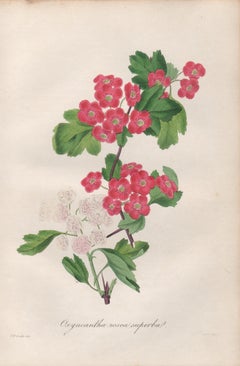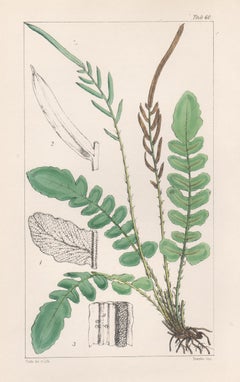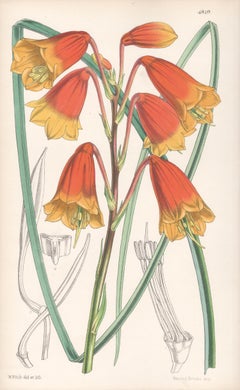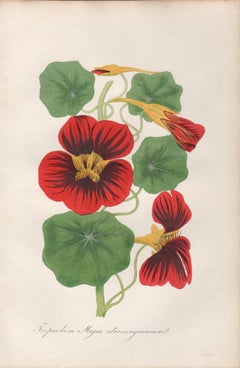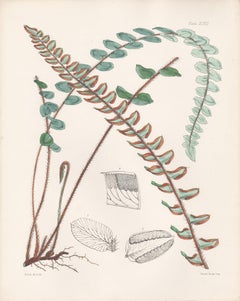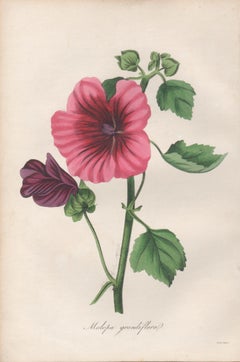Mid-19th Century Still-life Prints
to
2
40
4
2
Overall Width
to
Overall Height
to
2
3
2
2
1
1
216
261
2,332
1,645
17
19
36
28
91
249
331
458
546
216
186
43
3
15
13
5
4
3
3
2
2
2
2
1
1
1
1
1
1
1
1
1
1
23
22
4
4
3
4
3
9
3
Period: Mid-19th Century
Oxyacantha rosea superba, antique botanical pink flower engraving
Located in Melbourne, Victoria
Engraving with original hand-colouring. 1834. 230mm by 155mm. From Paxton's 'Magazine of botany and register of flowering plants' by Sir Joseph Paxton.
Category
Naturalistic Mid-19th Century Still-life Prints
Materials
Engraving
Ferns - Lomaria Nigra, antique fern lithograph print, 1854
Located in Melbourne, Victoria
Antique 19th century fern lithograph with original hand-colouring , 1854, after Walter Hood Fitch.
250mm by 170mm (sheet)
Walter Hood Fitch was one...
Category
Naturalistic Mid-19th Century Still-life Prints
Materials
Lithograph
Blandfordia Flammea, antique botanical Australian flower lithograph print
Located in Melbourne, Victoria
'Blandfordia Flame - Flame-flowered Blandfordia'
Botanical lithograph of an Australian native plant with original hand-colouring , 1854, by Walter Hood Fi...
Category
Naturalistic Mid-19th Century Still-life Prints
Materials
Lithograph
Tropaeolum Majus Atrosanguineum, antique botanical nasturtium flower engraving
Located in Melbourne, Victoria
Engraving with original hand-colouring. 1834. 230mm by 155mm. From Paxton's 'Magazine of botany and register of flowering plants' by Sir Joseph Paxton.
Category
Naturalistic Mid-19th Century Still-life Prints
Materials
Engraving
Round-leaved Pellaea, antique fern botanical plant lithograph print, 1859
Located in Melbourne, Victoria
Antique 19th century fern lithograph with original hand-colouring , 1859, after Walter Hood Fitch.
310mm by 250mm (sheet)
Walter Hood Fitch was one of the...
Category
Naturalistic Mid-19th Century Still-life Prints
Materials
Lithograph
Malopa grandiflora, antique botanical flower engraving
Located in Melbourne, Victoria
Engraving with original hand-colouring. 1834. 230mm by 155mm. From Paxton's 'Magazine of botany and register of flowering plants' by Sir Joseph Paxton.
Category
Naturalistic Mid-19th Century Still-life Prints
Materials
Engraving
Ribes sanguineum, antique botanical pink flower engraving
Located in Melbourne, Victoria
Engraving with original hand-colouring. 1834. 230mm by 155mm. From Paxton's 'Magazine of botany and register of flowering plants' by Sir Joseph Paxton.
Category
Naturalistic Mid-19th Century Still-life Prints
Materials
Engraving
Calceolaria viscosissima, antique botanical yellow flower engraving
Located in Melbourne, Victoria
Engraving with original hand-colouring. 1834. 230mm by 155mm. From Paxton's 'Magazine of botany and register of flowering plants' by Sir Joseph Paxton.
Category
Naturalistic Mid-19th Century Still-life Prints
Materials
Engraving
Azalea Pulchra, antique botanical flower engraving
Located in Melbourne, Victoria
Engraving with original hand-colouring. 1834. 230mm by 155mm. From Paxton's 'Magazine of botany and register of flowering plants' by Sir Joseph Paxton.
Category
Naturalistic Mid-19th Century Still-life Prints
Materials
Engraving
Hibiscus Lindlei, antique botanical pink flower engraving
Located in Melbourne, Victoria
Engraving with original hand-colouring. 1834. 230mm by 155mm. From Paxton's 'Magazine of botany and register of flowering plants' by Sir Joseph Paxton.
Category
Naturalistic Mid-19th Century Still-life Prints
Materials
Engraving
Petunia violacea, antique botanical purple flower engraving
Located in Melbourne, Victoria
Engraving with original hand-colouring. 1834. 230mm by 155mm. From Paxton's 'Magazine of botany and register of flowering plants' by Sir Joseph Paxton.
Category
Naturalistic Mid-19th Century Still-life Prints
Materials
Engraving
Mimulus roseus, antique botanical pink flower engraving
Located in Melbourne, Victoria
Engraving with original hand-colouring. 1834. 230mm by 155mm. From Paxton's 'Magazine of botany and register of flowering plants' by Sir Joseph Paxton.
Category
Naturalistic Mid-19th Century Still-life Prints
Materials
Engraving
Schizanthus Priestii, antique botanical white flower engraving
Located in Melbourne, Victoria
Engraving with original hand-colouring. 1834. 230mm by 155mm. From Paxton's 'Magazine of botany and register of flowering plants' by Sir Joseph Paxton.
Category
Naturalistic Mid-19th Century Still-life Prints
Materials
Engraving
Passiflora Cinnabarina, antique botanical Australian flower lithograph print
Located in Melbourne, Victoria
'Passiflora Cinnabarina' (Passionflower)
Botanical lithograph of an Australian native plant with original hand-colouring , 1871, by Walter Hood Fitch (1817...
Category
Naturalistic Mid-19th Century Still-life Prints
Materials
Lithograph
Nepenthes Villosa, antique botanical carnivorous pitcher plant lithograph print
Located in Melbourne, Victoria
'Nepenthes Villosa Hook. fil.'
Botanical lithograph with original hand-colouring of a carnivorous pitcher plant, native to Borneo. 1858.
Category
Naturalistic Mid-19th Century Still-life Prints
Materials
Lithograph
Zinnea violacea coccinea, antique botanical red flower engraving
Located in Melbourne, Victoria
Engraving with original hand-colouring. 1834. 230mm by 155mm. From Paxton's 'Magazine of botany and register of flowering plants' by Sir Joseph Paxton.
Category
Naturalistic Mid-19th Century Still-life Prints
Materials
Engraving
Streptanthera cuprea, antique botanical flower engraving
Located in Melbourne, Victoria
Engraving with original hand-colouring. 1834. 230mm by 155mm. From Paxton's 'Magazine of botany and register of flowering plants' by Sir Joseph Paxton.
Category
Naturalistic Mid-19th Century Still-life Prints
Materials
Engraving
Dendrobium Albo-Sanguineum, antique orchid botanical lithograph print, 1859
Located in Melbourne, Victoria
'Dendrobium Albo-Sanguineum – White and Sanguine Dendrobium'
Orchid lithograph with original hand-colouring , 1859, by Walter Hood Fitch (1817-1892).
25c...
Category
Naturalistic Mid-19th Century Still-life Prints
Materials
Lithograph
Azalea indica danielsiana, antique botanical pink flower engraving
Located in Melbourne, Victoria
Engraving with original hand-colouring. 1834. 230mm by 155mm. From Paxton's 'Magazine of botany and register of flowering plants' by Sir Joseph Paxton.
Category
Naturalistic Mid-19th Century Still-life Prints
Materials
Engraving
Passiflora Kermesina, antique botanical pink flower passionflower engraving
Located in Melbourne, Victoria
Engraving with original hand-colouring. 1834. 230mm by 155mm. From Paxton's 'Magazine of botany and register of flowering plants' by Sir Joseph Paxton.
Category
Naturalistic Mid-19th Century Still-life Prints
Materials
Engraving
Marica Sabini, antique botanical blue flower engraving
Located in Melbourne, Victoria
Engraving with original hand-colouring. 1834. 230mm by 155mm. From Paxton's 'Magazine of botany and register of flowering plants' by Sir Joseph Paxton.
Category
Naturalistic Mid-19th Century Still-life Prints
Materials
Engraving
Ipomopsis Elegans, antique botanical red flower engraving
Located in Melbourne, Victoria
Engraving with original hand-colouring. 1834. 230mm by 155mm. From Paxton's 'Magazine of botany and register of flowering plants' by Sir Joseph Paxton.
Category
Naturalistic Mid-19th Century Still-life Prints
Materials
Engraving
Gesneria Cooperi, antique botanical red flower engraving
Located in Melbourne, Victoria
Engraving with original hand-colouring. 1834. 230mm by 155mm. From Paxton's 'Magazine of botany and register of flowering plants' by Sir Joseph Paxton.
Category
Naturalistic Mid-19th Century Still-life Prints
Materials
Engraving
Cymbidium Eburneum, antique orchid botanical lithograph print, 1859
Located in Melbourne, Victoria
'Cymbidium Eburneum – The Ivory Cymbidium'
Orchid lithograph with original hand-colouring , 1859, by Walter Hood Fitch (1817-1892).
25cm by 15.5cm (sheet...
Category
Naturalistic Mid-19th Century Still-life Prints
Materials
Lithograph
Impatiens puberula (Soft Pink Balsam) /// Antique Botanical Flowers Plant Print
Located in Saint Augustine, FL
Artist: Nathaniel Wallich (Danish, 1786-1854)
Title: "Impatiens puberula (Soft Pink Balsam)" (Plate 193)
Portfolio: Plantae Asiaticae Rariores; or, Descriptions and Figures of a Select Number of Unpublished East Indian Plants
Year: 1830-1832
Medium: Original Hand-Colored Lithograph on J. Whatman paper
Limited edition: 254
Printer: Engelmann, Graf, Coindet & Co., London, UK
Publisher: Richard Taylor for Treuttel & Würtz, London, UK
Reference: Nissen BBI No. 2099; Pritzel No. 9957; Stafleu-Cowan No. 16583; Dunthorne No. 326
Sheet size: 21.13" x 14.13"
Condition: Has been professionally stored away for decades. In excellent condition with strong colors
Rare
Notes:
Provenance: private collection - Aspen, CO. Lithography by Maltese artist...
Category
Victorian Mid-19th Century Still-life Prints
Materials
Watercolor, Lithograph
Salvia cana (Woolly Sage) /// Botanical Botany Flowers Plants Science Art Print
Located in Saint Augustine, FL
Artist: Nathaniel Wallich (Danish, 1786-1854)
Title: "Salvia cana (Woolly Sage)" (Plate 116)
Portfolio: Plantae Asiaticae Rariores; or, Descriptions and Figures of a Select Number of Unpublished East Indian Plants
Year: 1830-1832
Medium: Original Hand-Colored Lithograph on J. Whatman paper
Limited edition: 254
Printer: Engelmann, Graf, Coindet & Co., London, UK
Publisher: Richard Taylor for Treuttel & Würtz, London, UK
Reference: Nissen BBI No. 2099; Pritzel No. 9957; Stafleu-Cowan No. 16583; Dunthorne No. 326
Sheet size: 21.13" x 14.25"
Condition: Some scattered tiny handling creases to sheet. Has been professionally stored away for decades. In excellent condition with strong colors
Rare
Notes:
Provenance: private collection - Aspen, CO. Lithography by Maltese artist...
Category
Victorian Mid-19th Century Still-life Prints
Materials
Watercolor, Lithograph
Eulophia Virens, antique orchid botanical lithograph print, 1866
Located in Melbourne, Victoria
'Eulophia Virens – Greenish Eulophia'
Orchid lithograph with original hand-colouring , 1866, by Walter Hood Fitch (1817-1892). Native orchid of Sri Lanka a...
Category
Naturalistic Mid-19th Century Still-life Prints
Materials
Lithograph
Set of Six Botanical Prints
Located in New York, NY
These colored engravings are from Edward Joseph Lowe's 1861 book "Beautiful Leaved Plants. Being a Description of the Most Beautiful Leaved Plants ...
Category
Mid-19th Century Still-life Prints
Materials
Laid Paper, Engraving
Pelvis in the Distance
By (after) Georgia O'Keeffe
Located in Brooklyn, NY
This is a reproduction of Georgia O'Keeffe's painting titled Pelvis in the Distance. Published by the now-defunct Shorewood Fine Art Publications in Connecticut, a renowned publisher...
Category
Modern Mid-19th Century Still-life Prints
Materials
Offset
$1,024 Sale Price
20% Off
Sedentary Koryaks; Reindeer/Nomad Koryaks
By John Webber
Located in Middletown, NY
Lithograph with hand coloring in watercolor on cream wove paper with a deckle edge, 8 3/4 x 12 1/2 inches (222 x 320 mm); sheet 15 1/4 x 20 7/8 inches (388 x 530 mm), full margins. I...
Category
French School Mid-19th Century Still-life Prints
Materials
Watercolor, Lithograph
Ferns - Platycerium Alcicorne, antique fern botanical colour woodblock print
Located in Melbourne, Victoria
Antique 19th century fern colour woodblock by Benjamin Fawcett after AF Lydon. From Edward J. Lowe’s 'Ferns: British and Exotic', 1867.
Accompanied by a sheet of descriptive text.
...
Category
Naturalistic Mid-19th Century Still-life Prints
Materials
Lithograph
Burtonia Villosa, antique botanical Australian flower lithograph print
Located in Melbourne, Victoria
'Burtonia Villosa - Villous Burtonia'
Botanical lithograph of a Western Australian native plant with original hand-colouring , 1848, by Walter Hood Fitch (1817-1892).
235mm by 145m...
Category
Naturalistic Mid-19th Century Still-life Prints
Materials
Lithograph
Ferns - Platycerium Grande, antique fern botanical colour woodblock print
Located in Melbourne, Victoria
Antique 19th century fern colour woodblock by Benjamin Fawcett after AF Lydon. From Edward J. Lowe’s 'Ferns: British and Exotic', 1867.
Accompanied by a sheet of descriptive text.
...
Category
Naturalistic Mid-19th Century Still-life Prints
Materials
Lithograph
A Set of Two Hand-Colored Engravings of an Ancient Roman Vase and a Tazza (Cup)
Located in Alamo, CA
This is a pair of framed hand-colored engravings of an ancient vase in the Palizzy Wares style and a silver gilt tazza (cup) with a cover, both from the 16th century. These were engraved under the supervision of Philip De La Motte...
Category
Victorian Mid-19th Century Still-life Prints
Materials
Engraving
Amaryllis formosissima (Sprekelia, Aztec Lily), antique botanical engraving
Located in Melbourne, Victoria
Engraving with original hand-colouring. 1834. 230mm by 155mm. From Paxton's 'Magazine of botany and register of flowering plants' by Sir Joseph Paxton.
Category
Naturalistic Mid-19th Century Still-life Prints
Materials
Engraving
Ferns - Platycerium Stemmaria, antique fern botanical colour woodblock print
Located in Melbourne, Victoria
Antique 19th century fern colour woodblock by Benjamin Fawcett after AF Lydon. From Edward J. Lowe’s 'Ferns: British and Exotic', 1867.
Accompanied by a sheet of descriptive text.
...
Category
Naturalistic Mid-19th Century Still-life Prints
Materials
Lithograph
Kaempferia rotunda, antique botanical purple orchid flower engraving
Located in Melbourne, Victoria
Engraving with original hand-colouring. 1834. 230mm by 155mm. From Paxton's 'Magazine of botany and register of flowering plants' by Sir Joseph Paxton.
Category
Naturalistic Mid-19th Century Still-life Prints
Materials
Engraving
Marica caerulea, antique botanical purple flower engraving
Located in Melbourne, Victoria
Engraving with original hand-colouring. 1834. 230mm by 155mm. From Paxton's 'Magazine of botany and register of flowering plants' by Sir Joseph Paxton.
Category
Naturalistic Mid-19th Century Still-life Prints
Materials
Engraving
Calcochortus luteus, antique botanical yellow flower engraving
Located in Melbourne, Victoria
Engraving with original hand-colouring. 1834. 230mm by 155mm. From Paxton's 'Magazine of botany and register of flowering plants' by Sir Joseph Paxton.
Category
Naturalistic Mid-19th Century Still-life Prints
Materials
Engraving
Poppies and Anemones - Lithograph form Ladies Flower Garden British Wildflowers
Located in Austin, TX
Artist: Lady Jane Webb Loudon (Brittish, 1800 - 1858)
9.5 x 8 in. page.
12 x 14 in. frame.
A color lithographic plate from The Ladies' Flower-Garden of British Wildflowers. By Mrs. ...
Category
Mid-19th Century Still-life Prints
Materials
Paper, Lithograph
Araucaria Excelsa (Norfolk Island Pine), antique Australian botanical lithograph
Located in Melbourne, Victoria
Araucaria Excelsa - Norfolk Island Pine, native to Norfolk Island, Australia.
From 'Flore des serres et des jardins de l'Europe' by Charles Lemaire an...
Category
Naturalistic Mid-19th Century Still-life Prints
Materials
Lithograph
Peter De Pannemaeker - Mid 19th Century Lithograph, Masdevallia Polysticta
Located in Corsham, GB
A charming, highly collectable chromolithograph from the 19th century book L'Illustration horticole. Artist name and flower species printed in plate. On paper.
Category
Mid-19th Century Still-life Prints
Materials
Lithograph
Uses and Customs - Etruscan Painting - Lithograph - 1862
Located in Roma, IT
Uses and Customs - Etruscan Painting is a lithograph on paper realized in 1862.
The artwork belongs to the Suite Uses and customs of all the peoples of the universe: " History of th...
Category
Modern Mid-19th Century Still-life Prints
Materials
Lithograph
Botanical from "The Ladies' Flower Garden of Ornamental Annuals" Yellow Loasa
Located in Austin, TX
Artist: Lady Jane Webb Loudon (British, 1800 - 1858)
9.5 x 8 in. page.
12 x 14 in. frame.
A "chromolithographic" plate from The Ladies' Flower-Garden of Ornamental Annuals. By Mrs. ...
Category
Mid-19th Century Still-life Prints
Materials
Paper, Lithograph
Buffalo Skull - Lithograph by Carlo Coleman - 1850
Located in Roma, IT
Buffalo Skull is an original lithography artwork on ivory paper realized by Carlo Coleman (1807-1874) in 1850.
Signed on the plate and dated. Image dime...
Category
Mid-19th Century Still-life Prints
Materials
Lithograph
19th century color lithograph still life vase flowers
Located in Milwaukee, WI
The present hand-colored lithograph is one of several decorative images of flower-filled vases published by Nathaniel Currier. This example contains roses, tulips, forget-me-nots, and others all within a vase with gold eagle head handles and an image of a beautiful young woman the belly.
16 x 11 inches, artwork
22.5 x 18.25 inches, frame
Entitled bottom center
Signed in the stone, lower left "Lith. and Pub. by N. Currier"
Inscribed lower right "152 Nassau St. Cor. of Spruce N.Y."
Copyrighted bottom center "Entered according to Act of Congress in the year 1848 by N. Currier in the Clerk's office of the Southern District of N.Y." with the number 249
Framed to conservation standards using 100 percent rag matting, housed in a lemon gold moulding.
Nathaniel Currier was a tall introspective man with a melancholy nature. He could captivate people with his piercing stare or charm them with his sparkling blue eyes. Nathaniel was born in Roxbury, Massachusetts on March 27th, 1813, the second of four children. His parents, Nathaniel and Hannah Currier, were distant cousins who lived a humble yet spartan life. When Nathaniel was eight years old, tragedy struck. Nathaniel’s father unexpectedly passed away leaving Nathaniel and his eleven-year-old brother Lorenzo to provide for the family. In addition to their mother, Nathaniel and Lorenzo had to care for six-year-old sister Elizabeth and two-year-old brother Charles. Nathaniel worked a series of odd jobs to support the family, and at fifteen, he started what would become a life-long career when he apprenticed in the Boston lithography shop of William and John Pendleton.
A Bavarian gentleman named Alois Senefelder invented lithography just 30 years prior to young Nat Currier’s apprenticeship. While under the employ of the brothers Pendleton, Nat was taught the art of lithography by the firm’s chief printer, a French national named Dubois, who brought the lithography trade to America.
Lithography involves grinding a piece of limestone flat and smooth then drawing in mirror image on the stone with a special grease pencil. After the image is completed, the stone is etched with a solution of aqua fortis leaving the greased areas in slight relief. Water is then used to wet the stone and greased-ink is rolled onto the raised areas. Since grease and water do not mix, the greased-ink is repelled by the moisture on the stone and clings to the original grease pencil lines. The stone is then placed in a press and used as a printing block to impart black on white images to paper.
In 1833, now twenty-years old and an accomplished lithographer, Nat Currier left Boston and moved to Philadelphia to do contract work for M.E.D. Brown, a noted engraver and printer. With the promise of good money, Currier hired on to help Brown prepare lithographic stones of scientific images for the American Journal of Sciences and Arts. When Nat completed the contract work in 1834, he traveled to New York City to work once again for his mentor John Pendleton, who was now operating his own shop located at 137 Broadway. Soon after the reunion, Pendleton expressed an interest in returning to Boston and offered to sell his print shop to Currier. Young Nat did not have the financial resources to buy the shop, but being the resourceful type he found another local printer by the name of Stodart. Together they bought Pendleton’s business.
The firm ‘Currier & Stodart’ specialized in "job" printing. They produced many different types of printed items, most notably music manuscripts for local publishers. By 1835, Stodart was frustrated that the business was not making enough money and he ended the partnership, taking his investment with him. With little more than some lithographic stones, and a talent for his trade, twenty-two year old Nat Currier set up shop in a temporary office at 1 Wall Street in New York City. He named his new enterprise ‘N. Currier, Lithographer’
Nathaniel continued as a job printer and duplicated everything from music sheets to architectural plans. He experimented with portraits, disaster scenes and memorial prints, and any thing that he could sell to the public from tables in front of his shop. During 1835 he produced a disaster print Ruins of the Planter's Hotel, New Orleans, which fell at two O’clock on the Morning of the 15th of May 1835, burying 50 persons, 40 of whom Escaped with their Lives. The public had a thirst for newsworthy events, and newspapers of the day did not include pictures. By producing this print, Nat gave the public a new way to “see” the news. The print sold reasonably well, an important fact that was not lost on Currier.
Nat met and married Eliza Farnsworth in 1840. He also produced a print that same year titled Awful Conflagration of the Steamboat Lexington in Long Island Sound on Monday Evening, January 18, 1840, by which melancholy occurrence over One Hundred Persons Perished. This print sold out very quickly, and Currier was approached by an enterprising publication who contracted him to print a single sheet addition of their paper, the New York Sun. This single page paper is presumed to be the first illustrated newspaper ever published.
The success of the Lexington print launched his career nationally and put him in a position to finally lift his family up. In 1841, Nat and Eliza had their first child, a son they named Edward West Currier. That same year Nat hired his twenty-one year old brother Charles and taught him the lithography trade, he also hired his artistically inclined brother Lorenzo to travel out west and make sketches of the new frontier as material for future prints. Charles worked for the firm on and off over the years, and invented a new type of lithographic crayon which he patented and named the Crayola. Lorenzo continued selling sketches to Nat for the next few years.
In 1843, Nat and Eliza had a daughter, Eliza West Currier, but tragedy struck in early 1847 when their young daughter died from a prolonged illness. Nat and Eliza were grief stricken, and Eliza, driven by despair, gave up on life and passed away just four months after her daughter’s death.
The subject of Nat Currier’s artwork changed following the death of his wife and daughter, and he produced many memorial prints and sentimental prints during the late 1840s. The memorial prints generally depicted grief stricken families posed by gravestones (the stones were left blank so the purchasers could fill in the names of the dearly departed). The sentimental prints usually depicted idealized portraits of women and children, titled with popular Christian names of the day.
Late in 1847, Nat Currier married Lura Ormsbee, a friend of the family. Lura was a self-sufficient woman, and she immediately set out to help Nat raise six-year-old Edward and get their house in order. In 1849, Lura delivered a son, Walter Black Currier, but fate dealt them a blow when young Walter died one year later. While Nat and Lura were grieving the loss of their new son, word came from San Francisco that Nat’s brother Lorenzo had also passed away from a brief illness. Nat sank deeper into his natural quiet melancholy. Friends stopped by to console the couple, and Lura began to set an extra place at their table for these unexpected guests. She continued this tradition throughout their lives.
In 1852, Charles introduced a friend, James Merritt Ives, to Nat and suggested he hire him as a bookkeeper. Jim Ives was a native New Yorker born in 1824 and raised on the grounds of Bellevue Hospital where his father was employed as superintendent. Jim was a self-trained artist and professional bookkeeper. He was also a plump and jovial man, presenting the exact opposite image of his new boss.
Jim Ives met Charles Currier through Caroline Clark, the object of Jim’s affection. Caroline’s sister Elizabeth was married to Charles, and Caroline was a close friend of the Currier family. Jim eventually proposed marriage to Caroline and solicited an introduction to Nat Currier, through Charles, in hopes of securing a more stable income to support his future wife.
Ives quickly set out to improve and modernize his new employer’s bookkeeping methods. He reorganized the firm’s sizable inventory, and used his artistic skills to streamline the firm’s production methods. By 1857, Nathaniel had become so dependent on Jims’ skills and initiative that he offered him a full partnership in the firm and appointed him general manager. The two men chose the name ‘Currier & Ives’ for the new partnership, and became close friends.
Currier & Ives produced their prints in a building at 33 Spruce Street where they occupied the third, fourth and fifth floors. The third floor was devoted to the hand operated printing presses that were built by Nat's cousin, Cyrus Currier, at his shop Cyrus Currier & Sons in Newark, NJ. The fourth floor found the artists, lithographers and the stone grinders at work. The fifth floor housed the coloring department, and was one of the earliest production lines in the country. The colorists were generally immigrant girls, mostly German, who came to America with some formal artistic training. Each colorist was responsible for adding a single color to a print. As a colorist finished applying their color, the print was passed down the line to the next colorist to add their color. The colorists worked from a master print displayed above their table, which showed where the proper colors were to be placed. At the end of the table was a touch up artist who checked the prints for quality, touching-in areas that may have been missed as it passed down the line. During the Civil War, demand for prints became so great that coloring stencils were developed to speed up production.
Although most Currier & Ives prints were colored in house, some were sent out to contract artists. The rate Currier & Ives paid these artists for coloring work was one dollar per one hundred small folios (a penny a print) and one dollar per one dozen large folios. Currier & Ives also offered uncolored prints to dealers, with instructions (included on the price list) on how to 'prepare the prints for coloring.' In addition, schools could order uncolored prints from the firm’s catalogue to use in their painting classes.
Nathaniel Currier and James Merritt Ives attracted a wide circle of friends during their years in business. Some of their more famous acquaintances included Horace Greeley, Phineas T. Barnum, and the outspoken abolitionists Rev. Henry Ward, and John Greenleaf Whittier (the latter being a cousin of Mr. Currier).
Nat Currier and Jim Ives described their business as "Publishers of Cheap and Popular Pictures" and produced many categories of prints. These included Disaster Scenes, Sentimental Images, Sports, Humor, Hunting Scenes, Politics, Religion, City and Rural Scenes, Trains, Ships, Fire Fighters, Famous Race Horses, Historical Portraits, and just about any other topic that satisfied the general public's taste. In all, the firm produced in excess of 7500 different titles, totaling over one million prints produced from 1835 to 1907.
Nat Currier retired in 1880, and signed over his share of the firm to his son Edward. Nat died eight years later at his summer home 'Lion’s Gate' in Amesbury, Massachusetts. Jim Ives remained active in the firm until his death in 1895, when his share of the firm passed to his eldest son, Chauncey.
In 1902, faced will failing health from the ravages of Tuberculosis, Edward Currier sold his share of the firm to Chauncey Ives...
Category
Romantic Mid-19th Century Still-life Prints
Materials
Watercolor, Lithograph
